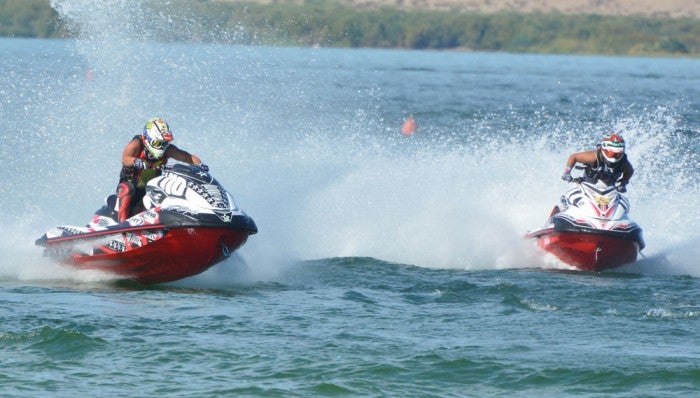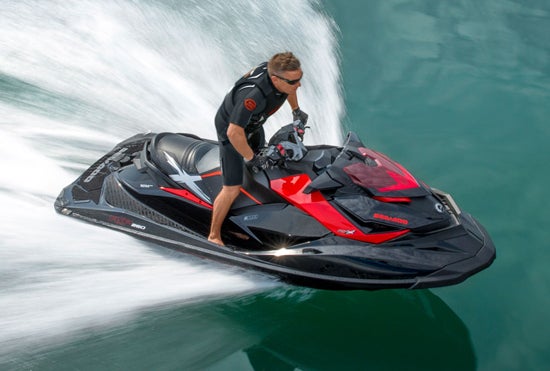How To Avoid Three Common PWC Handling Mistakes

Three simple tips can change the way you ride
Besides being just a lot of fun, riding a personal watercraft is also relatively simple. The controls are intuitive, the throttle easy to understand, and the handling mostly predictable. Yet year after year we still see people leaping and porpoising at the edge of control, spinning out or getting high-sided in a turn, or just plain suffering trying to keep up in a group ride in rough water.
The problem is that no one has ever taken the time to explain to them how to correct three of the most common handling mistakes. Do them a favor and share the following tips…or use them yourself for a far more enjoyable ride.
Porpoising
Like the name implies, porpoising is the up-and-down, leaping and surging effect that can make your PWC seem like it’s more of a bucking bronco than a smooth, sleek water vehicle. It was extremely common in the early standup days as beginning riders tried to master the craft. It continues to occur during hard “start-line” style accelerations on today’s high-powered models, as their overwhelming power causes the craft to literally leap out of the water at the first punch of the throttle.
 Think like a racer and move forward on the seat when you punch the throttle to keep the craft settled down on the water.
Think like a racer and move forward on the seat when you punch the throttle to keep the craft settled down on the water.The problem, in almost all cases, is that the rider’s position (and as a result, the majority of their body weight) is too far back. Typically, just moving farther forward on the seat or in the tray will put more weight toward the bow and settle the craft down. If you’re doing a hard acceleration from a dead start, anticipate that the bow will want to jump out of the water and react accordingly, trimming down the jet nozzle (if equipped) and then bracing your feet farther back in the footwells, and leaning your upper body up and over the handlebars to keep more weight over the nose. Once the craft is on plane, you can ease back into your normal sitting position and trim the bow angle back towards a middle-to-upward setting for best cruising results.
How To Carve a Race-Style Buoy Turn on a PWC
If you’re still riding a standup, or trying one for the first time, remember to slide forward once you get to your knees to get more weight toward the bow, and stay somewhat forward once you stand up.
Sliding Out
In the early days of sit-down watercraft, sliding or spinning out was a common occurrence in hard turns. The problem was the craft needed to stay relatively flat in the water to maintain the hull’s bite. Leaning into a turn may have seemed intuitive, but it often resulted in the stern breaking loose and sliding unexpectedly. The result was that a lot of riders needed to learn how to actually lean to the outside as they carved to the inside, a test of not only upper-body strength but also concentration as well. Nearly all of us took an unexpected swim or two while we were advancing up the learning curve.
How To Be A Better PWC Driver For Watersports
Thankfully, nearly all of today’s modern PWC finally reward that inside lean, and deliver a far more intuitive ride, but they can still shake loose on occasion. And at high speeds, nothing jacks up the heart rate more than feeling like you’re about to get squirrelly in the saddle.
 Keep your inside foot planted forward in the footwell to help keep the stern planted in a turn.
Keep your inside foot planted forward in the footwell to help keep the stern planted in a turn.One of the easiest and best ways to solve the problem is found in your foot placement. Keep your inside leg (the leg that is on the inside of the turn) planted more forward in the footwell, and slide your outside leg further towards the back, with just a little bit of weight. This will keep the stern planted, as well as provide you with more leverage to truly power through a corner. Downward trim also helps, as it places more of the forward portion of the hull in the water.
Should you want the stern to get loose on occasion, really try to move your weight to the inside and forward toward the nose when snapping off a medium-power turn with a quick blip of the throttle. You won’t get the wild spinouts of yesteryear, but you will get the occasional slide or 180-degree spin. Just be ready to recover when the hull once again takes a bite of the water.
Pounding in Rough Water
Even the best of today’s craft can deliver a jolting ride in really choppy, rough conditions. Staying seated and suffering your way through is no fun, so why not get out of the seat? Standing allows you to use your strong leg muscles as shock absorbers to absorb much of the jolting, as well as gives you a little higher vantage point to anticipate the worst of the waves and wakes. It may get tiring long-term, but it will definitely save your back.
How To Ride Your PWC To Match The Conditions
 Stand up and use your legs as shock absorbers in rough water.
Stand up and use your legs as shock absorbers in rough water.Can’t stand for lengthy periods? Cheat by lowering your butt onto the padded seat bolster meant to provide lower back support. It’s generally well-cushioned, and should allow you to still use some of that leg muscle to absorb the worst of the bumps. Another good suggestion is to activate your craft’s governed, slower-speed mode. It won’t allow the engine to react to sudden surges at the throttle with the same force you’d normally expect, smoothing out the ride considerably.
Get PersonalWatercraft.com in your Inbox!
Like PersonalWatercraft.com on Facebook
Comments
Most Popular

2025 Yamaha JetBlaster PRO 2-Up Review

2024 Kawasaki Jet Ski STX 160X Review

Remembering the Sea-Doo XP

Whatever Happened to the Wetbike?

2025 Yamaha JetBlaster Review











 Your Privacy Choices
Your Privacy Choices